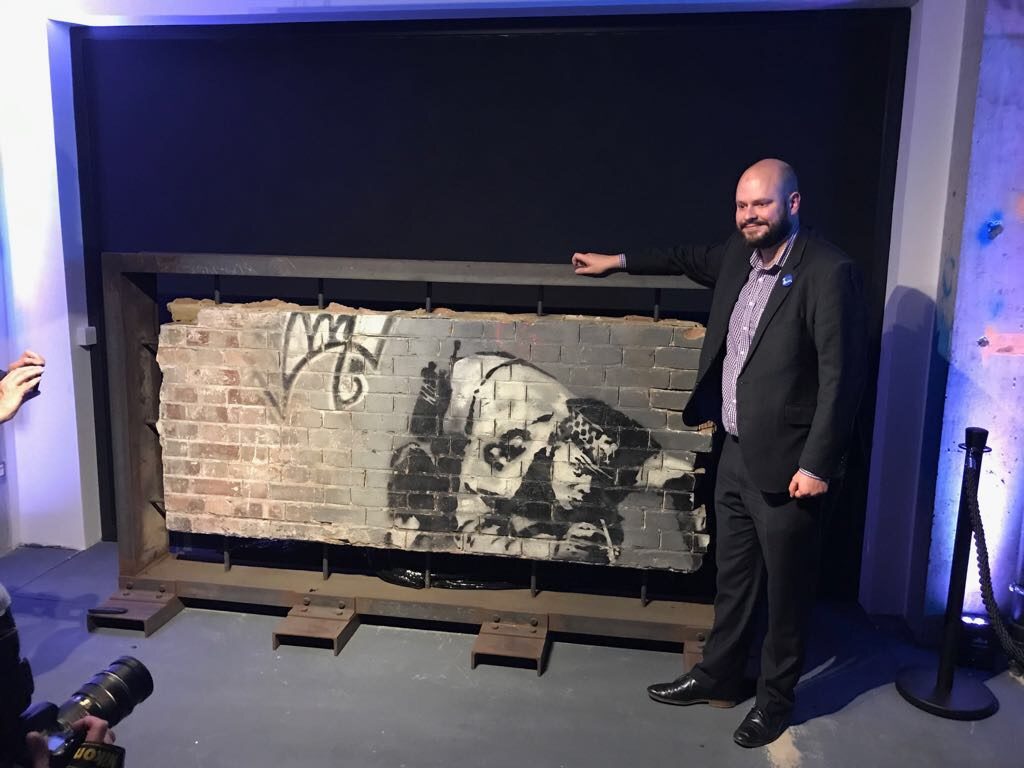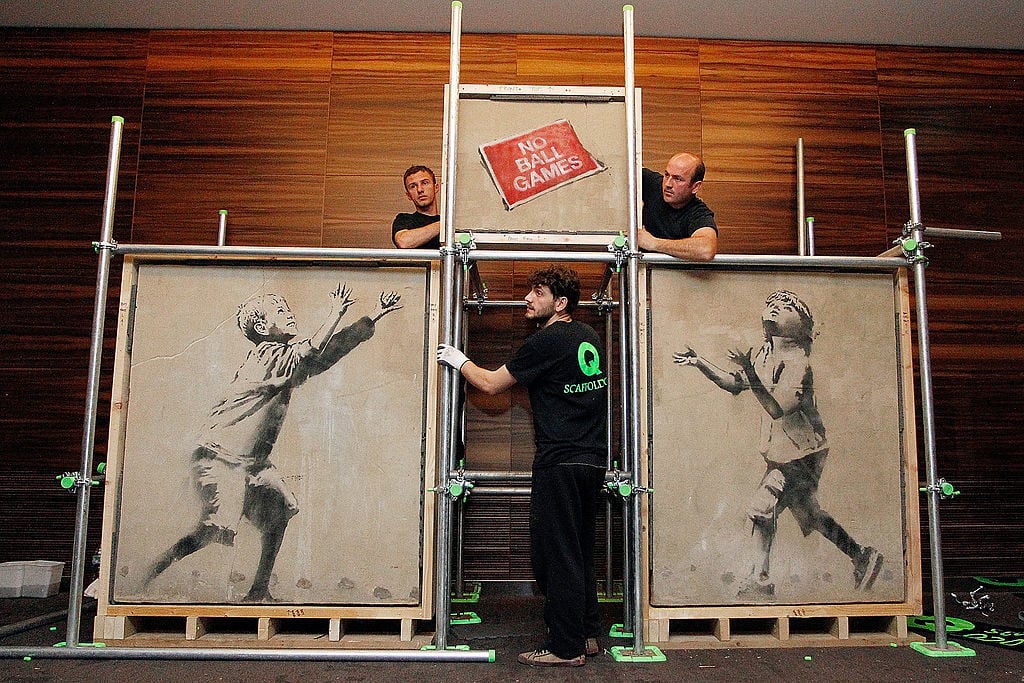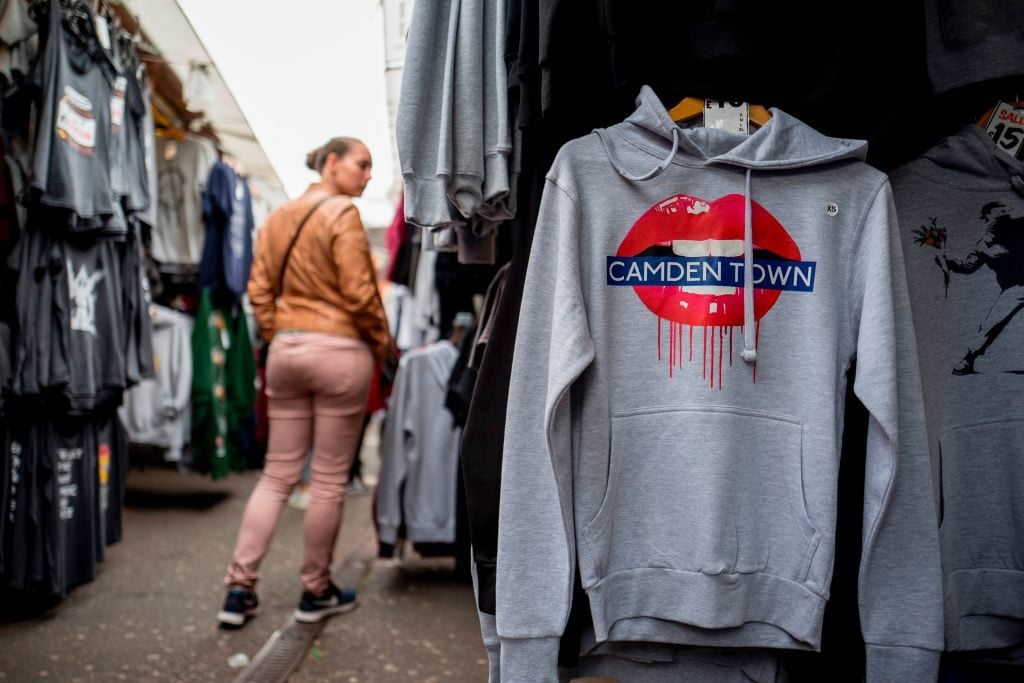Analysis
Where Money Grows on Walls: Inside the Multimillion-Dollar Banksy Cottage Industry
From luxury property developers to T-shirt sellers, everyone's making a buck off Banksy.

From luxury property developers to T-shirt sellers, everyone's making a buck off Banksy.

Naomi Rea

During Frieze Week in London, art world insiders and street art bloggers gathered around a new property development in Shoreditch to sip espresso martinis decorated with coconut-shaving lines of “cocaine” and catch the first glimpse of the newly restored Banksy work, Snorting Copper.
The wall had been painted over by Hackney Council during its staunch anti-graffiti years, then Jonathan Ellis and David Kyte of HC Developments bought the building in 2015. The restored piece was unveiled at the event by the mayor of Hackney, Philip Glanville, who did not fail to acknowledge the irony.
“We’ve been on a journey, and hopefully that’s recognized,” he said. “We’re now one of the few councils that have a street art policy written into how we manage our public spaces, and it’s something that we passionately believe in—so much so that we’re now in partnership with Stik, another street artist.” Hackney now plans to install a site-specific statue by Stik in Hoxton Square, which the mayor said he hopes “will be another addition to this area’s fantastic artistic legacy.”
This isn’t surprising given the value a Banksy painting can add to a property. Back in May, for example, a Banksy work that appeared on the side of a house on Portobello Road was part of the marketing campaign for a luxury development in Notting Hill, and Shoreditch has been a particular mecca for developers who appreciate the returns on what they call “creative placemaking.”
For their part, Ellis told artnet News that unveiling the Banksy wasn’t about trying to sell the flats, all but two of which had sold prior to their announcement this summer. “Someone should buy our property because they love our property, not just because it’s got a piece of art downstairs,” he said.

Construction workers put the final piece of Banksy’s No Ball Games into place during the “Stealing Banksy?” exhibition in London in 2014. Photo by Mary Turner/Getty Images.
Unlike other property owners who’ve had the fortune of a Banksy visit, they didn’t take to the wall with angle grinder and then auction it off to the highest bidder. Instead, they shipped it off to Cumbria to be restored, before returning it to its rightful home on Curtain Road.
“I’m sure Banksy has done alright for himself,” said Ellis, “but I can understand his concern about putting up a piece of art somewhere and someone just cutting it out of a wall. He’s putting this stuff up for reasons, and because he wants people to enjoy it, not just the person who owns that bit of wall, or the first person who gets there who’s got a hammer and a chisel.”
Once an outsider, Banksy has become an industry star, making his public works ever more vulnerable to “salvagers,” who want to cash in on his market value. Although he used to be represented by Steve Lazarides, Banksy has since established his own handling company, Pest Control, and most major auction houses now refuse to sell works unauthenticated by the service.
Tina Ziegler, director of London’s favorite street art fair, Moniker, told artnet News that the practice of removing pieces of wall and selling it is very frowned upon within the urban art community. “Moniker doesn’t do anything that’s been salvaged from the street,” she said. “We believe that the artwork that is on the street should be left on the street, because the artist’s intention in doing it on the street was to give it to the community, you know, to give it to everyone.”
During the 2014 Folkestone Triennial, a mural by Banksy depicting a woman looking at an empty plinth appeared on the side of a building. Before you could blink, the site’s tenants had it removed and tried to hawk the work for $740,000 in the US. Their plans were quickly foiled, however, when a local arts charity mounted a legal challenge, and the salvagers were ordered to ship the work back to the UK.
One group known for removing, exhibiting, and selling Banksy works, Sincura, staged a controversial exhibition in 2014 titled “Stealing Banksy?” The group salvaged Banksy’s Slave Labour mural from the owners of the Poundland store in Wood Green and eventually sold it for an impressive $1.1 million at a private auction at the London Film Museum in Covent Garden.
Banksy himself has made it clear that he was not involved in any of Sincura’s sales, although his statement that he thinks “it’s disgusting people are allowed to go around displaying art on walls without getting permission” was probably a little tongue-in-cheek. artnet News reached out to the Sincura Group and Sincura Arts for comment, but did not hear back.

Pedestrians browse stalls at Camden Market in London on September 3, 2017. Photo by Tolga Akmen/AFP/Getty Images.
Outside of the auction world, there are a number of figures who make their living from Banksy’s popularity in other ways. He’s immensely popular internationally and one of his stencils was recently voted the UK’s favorite work of art. Incidentally, that work, Girl With Balloon, is among the many that Sincura has removed from the street.
Although Banksy could probably have filed a billion copyright suits by now, he tends instead to call out his coattail-riders online.
Banksy has poked fun at the astonishing market value of his art. In 2013, he set up a stall in Central Park selling original work for $60, and nobody spotted anything extraordinary about the works on offer. In an amusing postscript to that sale, a pair of artists took advantage of the hype created by Banksy’s announcement of the stunt to set up an all but identical stand in Central Park—except they marketed theirs as “Fake Banksy,” and sold works with notarized certificates of inauthenticity. They still, however, couldn’t convince people the works were worthless.
When artnet News reached out to the artists, Dave Cicirelli and Lance Pilgrim, they said they weren’t motivated by profit (after production costs they walked away with about $300 each). “If we were motivated by profit, we would have taken advantage of the hype and charged more than Banksy’s original price, or have kept doing it. But we felt like we made our point, and we didn’t want to dilute it with cheap cash grabs.”
When asked if they had worried about copyright infringement, they admitted it had come up, but they felt it wasn’t much of a risk. Besides, they said, “Getting sued would be the best thing that ever happened to us. We’d be the stick of dynamite that Banksy used to blow up his own credibility!”
So what might Banksy really make of this multimillion-dollar industry that he doesn’t get to profit from? If we look to today’s urban contemporary art movement, which largely seeks to keep artwork in the public domain, it is reasonable to think he doesn’t much care. Museums and estate holders of many a master whose copyright has yet to expire waste valuable resources filing suits against bootleg retailers, and some might consider this a disservice to the public, by denying those whose closest encounter with the Mona Lisa might be on a bootleg hoodie in Camden Market. So, why not let them wear Banksy?